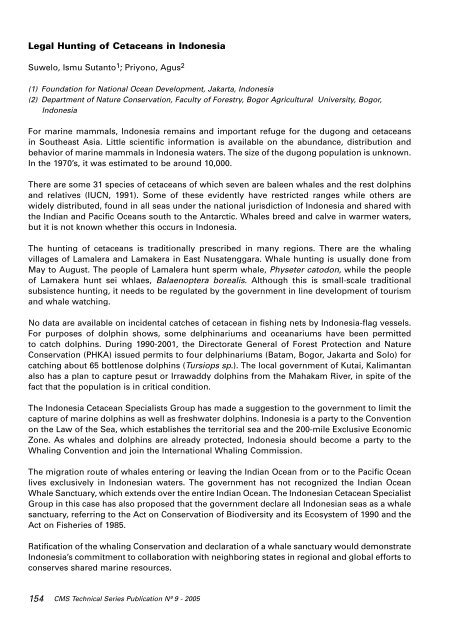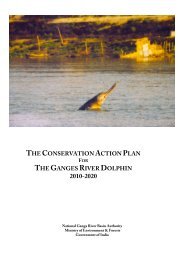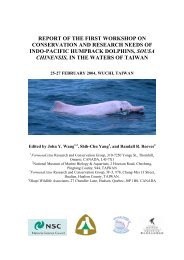Report of the Second Workshop on The Biology and Conservation of ...
Report of the Second Workshop on The Biology and Conservation of ...
Report of the Second Workshop on The Biology and Conservation of ...
Create successful ePaper yourself
Turn your PDF publications into a flip-book with our unique Google optimized e-Paper software.
Legal Hunting <str<strong>on</strong>g>of</str<strong>on</strong>g> Cetaceans in Ind<strong>on</strong>esiaSuwelo, Ismu Sutanto 1 ; Priy<strong>on</strong>o, Agus 2(1) Foundati<strong>on</strong> for Nati<strong>on</strong>al Ocean Development, Jakarta, Ind<strong>on</strong>esia(2) Department <str<strong>on</strong>g>of</str<strong>on</strong>g> Nature C<strong>on</strong>servati<strong>on</strong>, Faculty <str<strong>on</strong>g>of</str<strong>on</strong>g> Forestry, Bogor Agricultural University, Bogor,Ind<strong>on</strong>esiaFor marine mammals, Ind<strong>on</strong>esia remains <strong>and</strong> important refuge for <str<strong>on</strong>g>the</str<strong>on</strong>g> dug<strong>on</strong>g <strong>and</strong> cetaceansin Sou<str<strong>on</strong>g>the</str<strong>on</strong>g>ast Asia. Little scientific informati<strong>on</strong> is available <strong>on</strong> <str<strong>on</strong>g>the</str<strong>on</strong>g> abundance, distributi<strong>on</strong> <strong>and</strong>behavior <str<strong>on</strong>g>of</str<strong>on</strong>g> marine mammals in Ind<strong>on</strong>esia waters. <strong>The</strong> size <str<strong>on</strong>g>of</str<strong>on</strong>g> <str<strong>on</strong>g>the</str<strong>on</strong>g> dug<strong>on</strong>g populati<strong>on</strong> is unknown.In <str<strong>on</strong>g>the</str<strong>on</strong>g> 1970’s, it was estimated to be around 10,000.<strong>The</strong>re are some 31 species <str<strong>on</strong>g>of</str<strong>on</strong>g> cetaceans <str<strong>on</strong>g>of</str<strong>on</strong>g> which seven are baleen whales <strong>and</strong> <str<strong>on</strong>g>the</str<strong>on</strong>g> rest dolphins<strong>and</strong> relatives (IUCN, 1991). Some <str<strong>on</strong>g>of</str<strong>on</strong>g> <str<strong>on</strong>g>the</str<strong>on</strong>g>se evidently have restricted ranges while o<str<strong>on</strong>g>the</str<strong>on</strong>g>rs arewidely distributed, found in all seas under <str<strong>on</strong>g>the</str<strong>on</strong>g> nati<strong>on</strong>al jurisdicti<strong>on</strong> <str<strong>on</strong>g>of</str<strong>on</strong>g> Ind<strong>on</strong>esia <strong>and</strong> shared with<str<strong>on</strong>g>the</str<strong>on</strong>g> Indian <strong>and</strong> Pacific Oceans south to <str<strong>on</strong>g>the</str<strong>on</strong>g> Antarctic. Whales breed <strong>and</strong> calve in warmer waters,but it is not known whe<str<strong>on</strong>g>the</str<strong>on</strong>g>r this occurs in Ind<strong>on</strong>esia.<strong>The</strong> hunting <str<strong>on</strong>g>of</str<strong>on</strong>g> cetaceans is traditi<strong>on</strong>ally prescribed in many regi<strong>on</strong>s. <strong>The</strong>re are <str<strong>on</strong>g>the</str<strong>on</strong>g> whalingvillages <str<strong>on</strong>g>of</str<strong>on</strong>g> Lamalera <strong>and</strong> Lamakera in East Nusatenggara. Whale hunting is usually d<strong>on</strong>e fromMay to August. <strong>The</strong> people <str<strong>on</strong>g>of</str<strong>on</strong>g> Lamalera hunt sperm whale, Physeter catod<strong>on</strong>, while <str<strong>on</strong>g>the</str<strong>on</strong>g> people<str<strong>on</strong>g>of</str<strong>on</strong>g> Lamakera hunt sei whlaes, Balaenoptera borealis. Although this is small-scale traditi<strong>on</strong>alsubsistence hunting, it needs to be regulated by <str<strong>on</strong>g>the</str<strong>on</strong>g> government in line development <str<strong>on</strong>g>of</str<strong>on</strong>g> tourism<strong>and</strong> whale watching.No data are available <strong>on</strong> incidental catches <str<strong>on</strong>g>of</str<strong>on</strong>g> cetacean in fishing nets by Ind<strong>on</strong>esia-flag vessels.For purposes <str<strong>on</strong>g>of</str<strong>on</strong>g> dolphin shows, some delphinariums <strong>and</strong> oceanariums have been permittedto catch dolphins. During 1990-2001, <str<strong>on</strong>g>the</str<strong>on</strong>g> Directorate General <str<strong>on</strong>g>of</str<strong>on</strong>g> Forest Protecti<strong>on</strong> <strong>and</strong> NatureC<strong>on</strong>servati<strong>on</strong> (PHKA) issued permits to four delphinariums (Batam, Bogor, Jakarta <strong>and</strong> Solo) forcatching about 65 bottlenose dolphins (Tursiops sp.). <strong>The</strong> local government <str<strong>on</strong>g>of</str<strong>on</strong>g> Kutai, Kalimantanalso has a plan to capture pesut or Irrawaddy dolphins from <str<strong>on</strong>g>the</str<strong>on</strong>g> Mahakam River, in spite <str<strong>on</strong>g>of</str<strong>on</strong>g> <str<strong>on</strong>g>the</str<strong>on</strong>g>fact that <str<strong>on</strong>g>the</str<strong>on</strong>g> populati<strong>on</strong> is in critical c<strong>on</strong>diti<strong>on</strong>.<strong>The</strong> Ind<strong>on</strong>esia Cetacean Specialists Group has made a suggesti<strong>on</strong> to <str<strong>on</strong>g>the</str<strong>on</strong>g> government to limit <str<strong>on</strong>g>the</str<strong>on</strong>g>capture <str<strong>on</strong>g>of</str<strong>on</strong>g> marine dolphins as well as freshwater dolphins. Ind<strong>on</strong>esia is a party to <str<strong>on</strong>g>the</str<strong>on</strong>g> C<strong>on</strong>venti<strong>on</strong><strong>on</strong> <str<strong>on</strong>g>the</str<strong>on</strong>g> Law <str<strong>on</strong>g>of</str<strong>on</strong>g> <str<strong>on</strong>g>the</str<strong>on</strong>g> Sea, which establishes <str<strong>on</strong>g>the</str<strong>on</strong>g> territorial sea <strong>and</strong> <str<strong>on</strong>g>the</str<strong>on</strong>g> 200-mile Exclusive Ec<strong>on</strong>omicZ<strong>on</strong>e. As whales <strong>and</strong> dolphins are already protected, Ind<strong>on</strong>esia should become a party to <str<strong>on</strong>g>the</str<strong>on</strong>g>Whaling C<strong>on</strong>venti<strong>on</strong> <strong>and</strong> join <str<strong>on</strong>g>the</str<strong>on</strong>g> Internati<strong>on</strong>al Whaling Commissi<strong>on</strong>.<strong>The</strong> migrati<strong>on</strong> route <str<strong>on</strong>g>of</str<strong>on</strong>g> whales entering or leaving <str<strong>on</strong>g>the</str<strong>on</strong>g> Indian Ocean from or to <str<strong>on</strong>g>the</str<strong>on</strong>g> Pacific Oceanlives exclusively in Ind<strong>on</strong>esian waters. <strong>The</strong> government has not recognized <str<strong>on</strong>g>the</str<strong>on</strong>g> Indian OceanWhale Sanctuary, which extends over <str<strong>on</strong>g>the</str<strong>on</strong>g> entire Indian Ocean. <strong>The</strong> Ind<strong>on</strong>esian Cetacean SpecialistGroup in this case has also proposed that <str<strong>on</strong>g>the</str<strong>on</strong>g> government declare all Ind<strong>on</strong>esian seas as a whalesanctuary, referring to <str<strong>on</strong>g>the</str<strong>on</strong>g> Act <strong>on</strong> C<strong>on</strong>servati<strong>on</strong> <str<strong>on</strong>g>of</str<strong>on</strong>g> Biodiversity <strong>and</strong> its Ecosystem <str<strong>on</strong>g>of</str<strong>on</strong>g> 1990 <strong>and</strong> <str<strong>on</strong>g>the</str<strong>on</strong>g>Act <strong>on</strong> Fisheries <str<strong>on</strong>g>of</str<strong>on</strong>g> 1985.Ratificati<strong>on</strong> <str<strong>on</strong>g>of</str<strong>on</strong>g> <str<strong>on</strong>g>the</str<strong>on</strong>g> whaling C<strong>on</strong>servati<strong>on</strong> <strong>and</strong> declarati<strong>on</strong> <str<strong>on</strong>g>of</str<strong>on</strong>g> a whale sanctuary would dem<strong>on</strong>strateInd<strong>on</strong>esia’s commitment to collaborati<strong>on</strong> with neighboring states in regi<strong>on</strong>al <strong>and</strong> global efforts toc<strong>on</strong>serves shared marine resources.154 CMS Technical Series Publicati<strong>on</strong> Nº 9 - 2005





